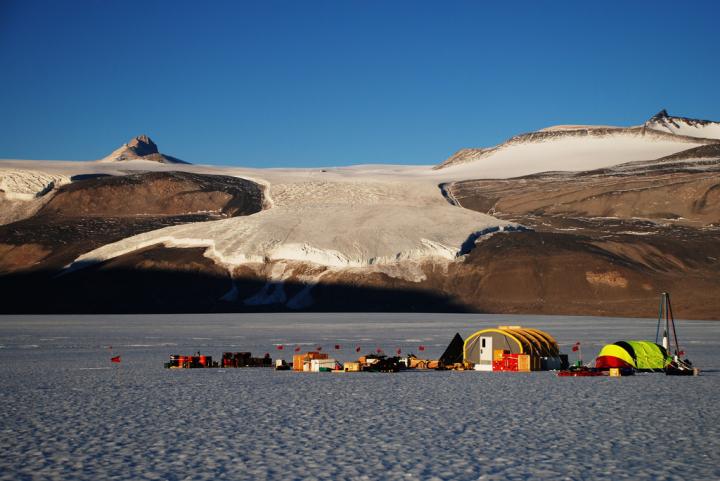

Researchers measured increases in atmospheric nitrous oxide concentrations about 16,000 to 10,000 years ago using ice from Taylor Glacier in Antarctica.
Credit: Adrian Schilt
An international team of scientists analyzed air extracted from bubbles enclosed in ancient polar ice from Taylor Glacier in Antarctica, allowing for the reconstruction of the past atmospheric composition. The analysis documented a 30 percent increase in atmospheric nitrous oxide concentrations from 16,000 years ago to 10,000 years ago.
This rise in N2O was caused by changes in environmental conditions in the ocean and on land, scientists say, and contributed to the warming at the end of the ice age and the melting of large ice sheets that then existed.
The findings add an important new element to studies of how Earth may respond to a warming climate in the future. Results of the study, which was funded by the U.S. National Science Foundation and the Swiss National Science Foundation, are being published this week in the journal Nature.
“We found that marine and terrestrial sources contributed about equally to the overall increase of nitrous oxide concentrations and generally evolved in parallel at the end of the last ice age,” said lead author Adrian Schilt, who did much of the work as a post-doctoral researcher at Oregon State University. Schilt then continued to work on the study at the Oeschger Centre for Climate Change Research at the University of Bern in Switzerland.
“The end of the last ice age represents a partial analog to modern warming and allows us to study the response of natural nitrous oxide emissions to changing environmental conditions,” Schilt added. “This will allow us to better understand what might happen in the future.”
Nitrous oxide is perhaps best known as laughing gas, but it is also produced by microbes on land and in the ocean in processes that occur naturally, but can be enhanced by human activity. Marine nitrous oxide production is linked closely to low oxygen conditions in the upper ocean and global warming is predicted to intensify the low-oxygen zones in many of the world's ocean basins. N2O also destroys ozone in the stratosphere.
“Warming makes terrestrial microbes produce more nitrous oxide,” noted co-author Edward Brook, an Oregon State paleoclimatologist whose research team included Schilt. “Greenhouse gases go up and down over time, and we'd like to know more about why that happens and how it affects climate.”
Nitrous oxide is among the most difficult greenhouse gases to study in attempting to reconstruct the Earth's climate history through ice core analysis. The specific technique that the Oregon State research team used requires large samples of pristine ice that date back to the desired time of study – in this case, between about 16,000 and 10,000 years ago.
The unusual way in which Taylor Glacier is configured allowed the scientists to extract ice samples from the surface of the glacier instead of drilling deep in the polar ice cap because older ice is transported upward near the glacier margins, said Brook, a professor in Oregon State's College of Earth, Ocean, and Atmospheric Sciences.
The scientists were able to discern the contributions of marine and terrestrial nitrous oxide through analysis of isotopic ratios, which fingerprint the different sources of N2O in the atmosphere.
“The scientific community knew roughly what the N2O concentration trends were prior to this study,” Brook said, “but these findings confirm that and provide more exact details about changes in sources. As nitrous oxide in the atmosphere continues to increase – along with carbon dioxide and methane – we now will be able to more accurately assess where those contributions are coming from and the rate of the increase.”
Atmospheric N2O was roughly 200 parts per billion at the peak of the ice age about 20,000 years ago then rose to 260 ppb by 10,000 years ago. As of 2014, atmospheric N2Owas measured at about 327 ppb, an increase attributed primarily to agricultural influences.
Although the N2O increase at the end of the last ice age was almost equally attributable to marine and terrestrial sources, the scientists say, there were some differences.
“Our data showed that terrestrial emissions changed faster than marine emissions, which was highlighted by a fast increase of emissions on land that preceded the increase in marine emissions,” Schilt pointed out. “It appears to be a direct response to a rapid temperature change between 15,000 and 14,000 years ago.”
That finding underscores the complexity of analyzing how Earth responds to changing conditions that have to account for marine and terrestrial influences; natural variability; the influence of different greenhouse gases; and a host of other factors, Brook said.
“Natural sources of N2O are predicted to increase in the future and this study will help up test predictions on how the Earth will respond,” Brook said.
Note to Reporters: Financial support was provided by the Swiss and U.S. National Science Foundations (NSF), including a Swiss NSF fellowship for prospective researchers (139404) to A.S., U.S. NSF grant PLR08-38936 to E.J.B., and U.S. NSF grant PLR08-39031 to J.P.S.
An images is available to illustrate this article at: https://flic.kr/p/poWBsJ











